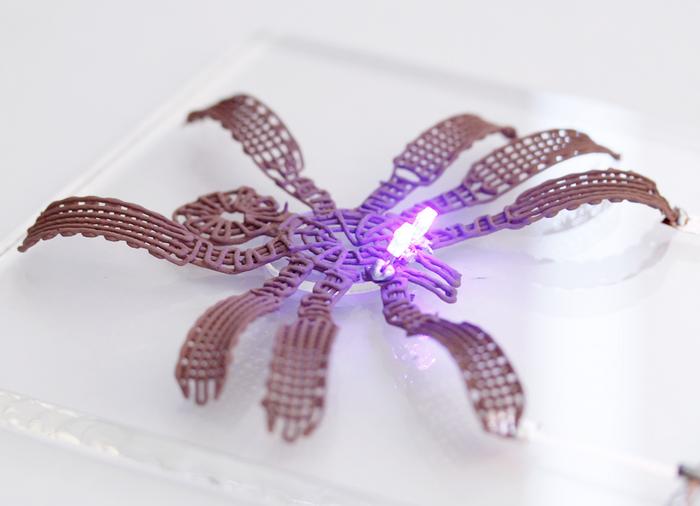Jul 06 2023
3D Printing With Metallic Gel
 One of the futuristic technologies that I find most promising is 3D printing (additive manufacturing). 3D printing has already created a revolution in manufacturing, but I think the general public does not have a high awareness of this technology because it is not yet at the point where it is ready to be a routine in-home appliance. It probably seems like an expensive toy. But in reality it is a key and rapidly growing prototyping and manufacturing technology. Importantly, there is tremendous potential for the technology to advance, and we are far away from a fully mature manifestation of 3D printing.
One of the futuristic technologies that I find most promising is 3D printing (additive manufacturing). 3D printing has already created a revolution in manufacturing, but I think the general public does not have a high awareness of this technology because it is not yet at the point where it is ready to be a routine in-home appliance. It probably seems like an expensive toy. But in reality it is a key and rapidly growing prototyping and manufacturing technology. Importantly, there is tremendous potential for the technology to advance, and we are far away from a fully mature manifestation of 3D printing.
The basic technology connected the virtual world with the physical analog world. You start with a digital design for an object, which can be created using software or by scanning an existing physical object. The 3D printer then prints the object from the digital design, with a print head laying down the material layer by layer, building up the three dimensional object. Sometimes supports need to be added so that the resulting object can stand upright while printing. One limitation of 3D printers is their dimensions – thy can only build object as large as their print area. However, some newer printers have a conveyor belt for a platform which allows for one dimension to be virtually unlimited.
One of the challenges of 3D printing technology has been printing with metals. Dealing with plastics and resins were the low hanging fruit because they can be extruded by the print head and rapidly cool at room temperature to a solid object, maintaining their structure. Hard plastic parts are great for many applications, but not all. The wider a range of material that 3D printers can use the better, and metal 3D printing has been the holy grail.
There are several methods for metal 3D printing. They mostly use metal powder which is then sintered (melted so that the grains stick together and fuse) using a laser or electron beams to melt the powder. These machines are expensive, most greater than $1 million, and are difficult to use, often requiring post-printing processing. The various methods differ in their size range and precision. Selective laser melting (SLM) is perhaps the most mature version of 3D metal printing, capable of producing precise intricate objects that are not machinable.
An up and coming method is bound powder extrusion. Here the metal powder is bound in a resin so that it can be 3D printed more like a traditional plastic or resin printer. Then the resulting object is washed to remove most of the resin. Finally it is sintered in an oven, removing any remaining resin and sintering the metal powder into a solid metal object. This process takes three machines (printer, washer, sinter) costing about $250,000.
A new report details a potential new method of 3D printing with metals using a metallic gel in a pendular suspension. They report:
“This paper reports printable metallic gels (pendular suspensions) consisting of an aqueous suspension of copper particles connected by bridges of liquid eutectic gallium indium alloy (EGaIn). Pendular suspensions rely on capillary forces to form networks between solid particles with a composition-dependent rheology…”
The solid metal particles are essentially bound together loosely by a liquid creating capillary forces. “Rheology” is the study of how material flows, and the essence of this technology is getting the metal to flow like a liquid. The benefit of this method is that you end up with a gel that is 97% metal. Once it is printed into shape you can let it dry slowly without any heating or sintering necessary. However, if you heat the printed object it will deform in predictable ways as it dries. This allows for “4D printing”, adding an element of time. New shapes can be created in this way.
The result is a metallic 3D object. However, the authors of the study emphasize that a benefit of this method is creating objects that can conduct electricity. You can therefore use it to print electronic parts. I didn’t dig deep enough to see how strong the parts will be, so perhaps they are not as strong as sintered parted and therefore not usable to every application. But being able to 3D print in a single step without sintering a metallic part that is conductive, opens up new manufacturing possibilities.
This one advance is a good example of the fact that we are still on the steep part of the curve when it comes to 3D printing. The basic technology works – translating digital designs into physical objects through additive manufacturing. But there is still a lot of opportunities to explore different and perhaps better ways to leverage this basic concept, expanding the materials used, the resulting physical properties, and therefore the potential applications. 3D printing is causing a quiet revolution in our manufacturing, but it has not reached a tipping point yet. Like most technologies it follows the typical “S” curve – slow progress at first, then an explosion of adoption, followed by leveling off. We seem to be at the beginning of the explosion, and we are certainly far from leveling off.






